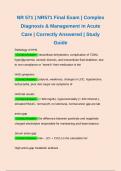NR 571 | NR571 Final Exam | Complex
Diagnosis & Management in Acute
Care | Correctly Answered | Study
Guide
Pathology of HHS
- Correct Answer - intracellular dehydration, complication of T2DM,
hyperglycaemia, osmotic diuresis, and extracellular fluid depletion, due
to non-compliance or "stretch" their medication is the
HHS symptoms
- Correct Answer - polyuria, weakness, changes in LOC, hypotension,
tachycardia, poor skin turgor are symptoms of
HHS lab results
- Correct Answer - (> 600 mg/dL), hyperosmolality (> 320 mOsm/L),
elevated HbA1C, normal pH, no ketonuria, normal anion gap are lab
anion gap
- Correct Answer - the difference between positively and negatively
charged electrolytes responsible for maintaining acid-base balance.
Serum anion gap
- Correct Answer - Na+ - (Cl- + CO2-) is the calculation for
High-anion-gap metabolic acidosis
,- Correct Answer - ketoacidosis, lactic acidosis, severe chronic renal
failure, toxic ingestion are due to
Non-anion-gap metabolic acidosis
- Correct Answer - diarrhea, nephrotic syndrome, renal tubular acidosis,
renal failure, acetazolamide, adrenal insufficiency are due to
non-anion gap metabolic acidosis exists
- Correct Answer - calculate the urine anion gap by measuring urine
electrolytes should do to help narrow the differential if
DKA and HHS most common
- Correct Answer - precipitating factor in both conditions is infection,
CVA, MI, alcohol abuse, pancreatitis, trauma, and noncompliance with
medication.
Work up for DKA and HHS
- Correct Answer - CBC (hemoglobin and WBCs), CMP (electrolytes,
renal function, and calculated anion gap), serum osmolality, ABG (pH,
HCO3, pCO2, pO2), lactic acid, beta-hydroxybutyrate (measures the
most abundant ketone during DKA), U/A (ketones and glucose), urine
culture, if U/A is positive, blood cultures (septicemia), CXR (pneumonia),
lipase & amylase is the work up for
General Treatment for DKA and HHS
- Correct Answer - Treatment for both conditions should simultaneously
address fluid loss, electrolyte imbalance, and acidosis for
DKA supportive in DKA &HHS
, - Correct Answer - protect airway; oxygen as needed, hourly urine output
and blood glucose monitoring
DKA correction fluid loss
- Correct Answer - 1-2-liter (0.9% NS) first 2 hours, check NA after; if ok
0.45% NS at 250-500 mL/h; if low 0.9% NS, BS 250 d5 1/2, fluid loss
give 4-6 liters, 50% of fluid deficit in the first 8-12 h; total volume
replacement within 24-36 h is
DKA correction insulin
- Correct Answer - > 3.3K before insulin, give 0.1 insulin bolus then 0.1 u
infusion; insulin bolus and increase if sugar don't drop, drop by 100 no
more then 200 next 4hrs, drip till labs good, wean when 150-250, stop 2-
4hr after SC injections
sodium bicarbonate drip
- Correct Answer - only infused with ? in severe acidosis or
hemodynamically unstable; Correct severe acidosis (pH<7.1) until pH
reaches > 7.1
Electrolytes DKA and HHS correction:
- Correct Answer - will drop with insulin, urine > 50 before you give K+, if
>5.2 do not give check q2, if K+ is < 3.3 add 10-20 mEq to fluids until >
3.3 is for
HHS correction fluid
- Correct Answer - fluid is priority, 1-2-liters (0.9% NS) first 2 hours, if NA
low use NS, normal give 0.45% at 250-500hr. BS 250 D51/2, fluid loss 6-
12L, 50% deficit give first 8-12hr, rest next 24-36hr for what condition




